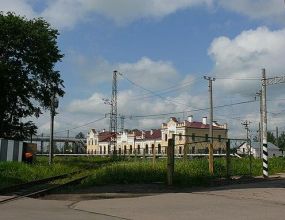 Source: Wikimedia Commons, Дар Ветер, CC BY-SA 3.0.
Source: Wikimedia Commons, Дар Ветер, CC BY-SA 3.0. In Chudovo, a small town in the Novgorod region of Russia, one of the most striking observations is the significant presence of the Roma community. This community’s roots in Chudovo trace back to the 1986 Chernobyl disaster, when many Roma were forced to leave the Gomel region of Belarus where they had a big settlement to relocate due to radioactive contamination. Their journey underscores the broader challenges faced by marginalized communities in Russia and the need for more inclusive and equitable policies.
In Chudovo, a small town in the Novgorod region of Russia, one of the most striking observations is the significant presence of Roma community. This community’s roots in Chudovo trace back to the 1986 Chernobyl disaster, when many Roma were forced to leave the Gomel region of Belarus where they had a big settlement to relocate due to radioactive contamination. Their journey underscores the broader challenges faced by marginalized communities in Russia and the need for more inclusive and equitable policies.
Settlement
Following the Chernobyl accident, the Roma community negotiated with local authorities in Chudovo to relocate there. They did not receive the official status of "forced migrants," which would have entitled them to government support for resettlement. Instead, they moved under a policy allowing free relocation from contaminated zones. Initially, the Roma were settled in the village of Pridorozhnoye, located 10 kilometers from Chudovo, which lacked basic amenities like electricity, water, and schools. Living conditions were harsh, with many families residing in tents.
By 1988, seeking better living conditions, the Roma community began constructing homes on the outskirts of Chudovo, transforming a swampy area into what is now a neighborhood of about 200 houses. This expansion was driven by both new arrivals and the natural growth of families needing separate homes as children grew up. Significant part of the local Roma (of those who work) are engaged in car repairment service and other services that are in demand near the main road, adapting their traditional tinsmithing trade to modern conditions (protecting metal from corrosion, preparing metal for soldering by applying a thin layer of tin to it).
Legal and social challenges
Despite their efforts to integrate, the Roma community in Chudovo faces significant legal and social challenges. In 2005, a formal agreement was signed between the local authorities and the Roma leader, defining a "compact living area for Roma." The authorities promised to legalize existing homes, while the Roma agreed not to build new ones. Unfortunately, both sides failed to uphold the agreement, and many houses remain illegal constructions.
Legally, almost all Roma homes are considered unauthorized structures. As of now, around 2,000 Roma live in Chudovo, half of whom are children. The community has established its own school, housed in a legally constructed Roma home, which now educates up to the sixth grade.
Forced evictions and court battles
In the fall of 2006, legal actions were taken to demolish six newly constructed homes. Despite legal representation from human rights organization “Memorial”, the courts ruled in favor of demolition. In 2007, an operation involving law enforcement dismantled these homes, although some Roma already dismantled their own homes to avoid further conflict.
In 2008, additional lawsuits targeted homes in the settlement due to the presence of a non-operational asphalt plant’s sanitary conditions. Agreements were reached to provide land lots for affected families in Pridorozhnoye, though all demolition orders were upheld with temporary suspensions granted.
Most Roma are still officially registered in Pridorozhnoye, despite many living in Chudovo. At the settlement's territory there are three “legal houses”, including a school; in one of the houses more than 80 people are registered, even in the school there are at least 5; a certain number are registered in Chudovo in local people’s houses (agreed with the owners). Legal complexities regarding their residence registration remain, with local prosecutors challenging the legality of these registrations. However, some judicial decisions have favored the Roma, rejecting attempts to annul their registrations due to procedural delays and public knowledge of their living arrangements.
The local administration is working on a general development plan, which may legalize about 50% of the existing Roma homes. The Russian government has also reported plans to the UN for the legalization, reconstruction, or demolition of various Roma homes, although these plans are still in early stages.
Despite these challenges, the Roma community in Chudovo remains resilient, maintaining their traditional lifestyle and culture. They continue to celebrate their heritage and adapt to modern conditions, much like their ancestors. However, tensions remain with local authorities, accomponied by ongoing legal and social issues.